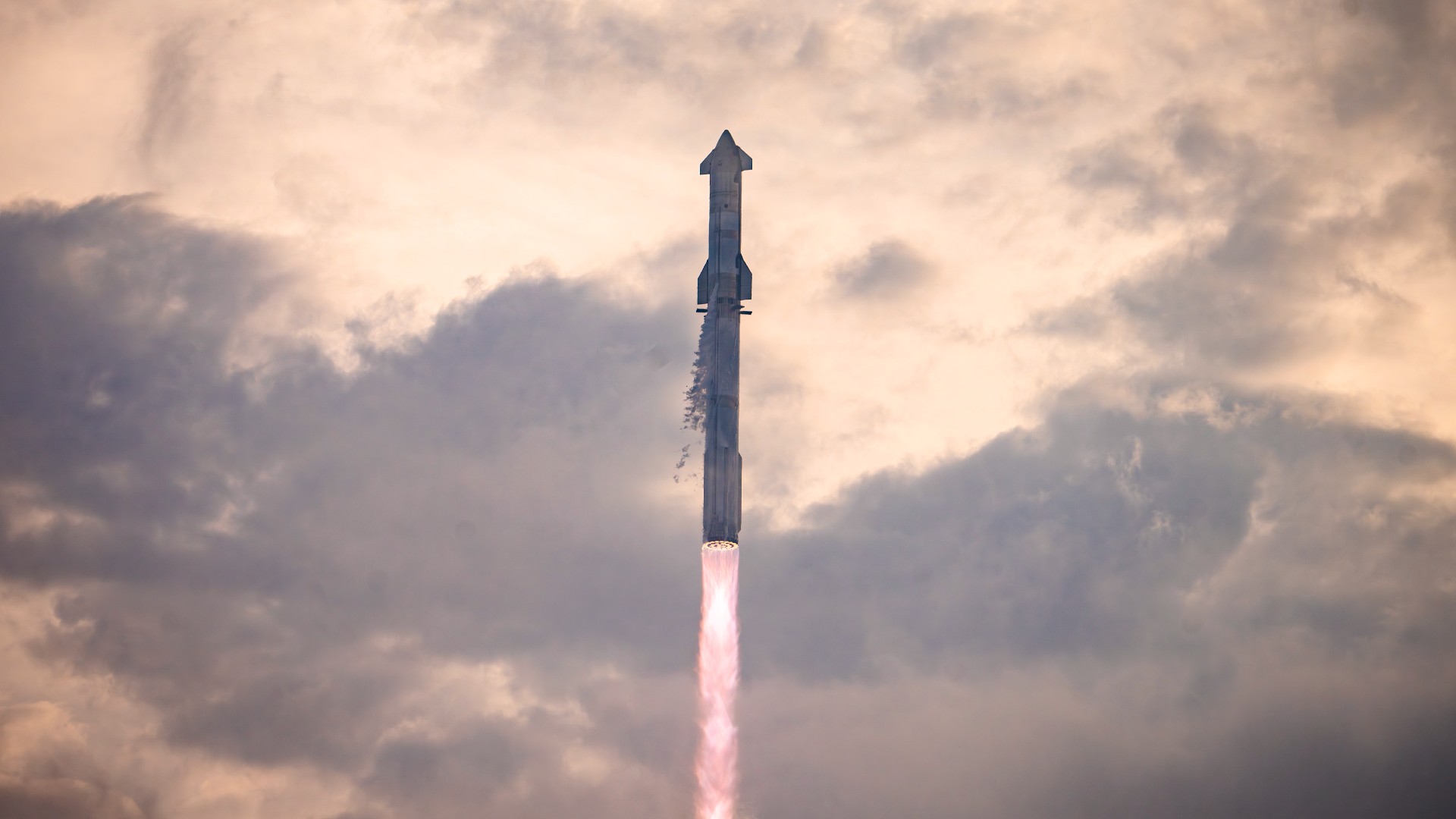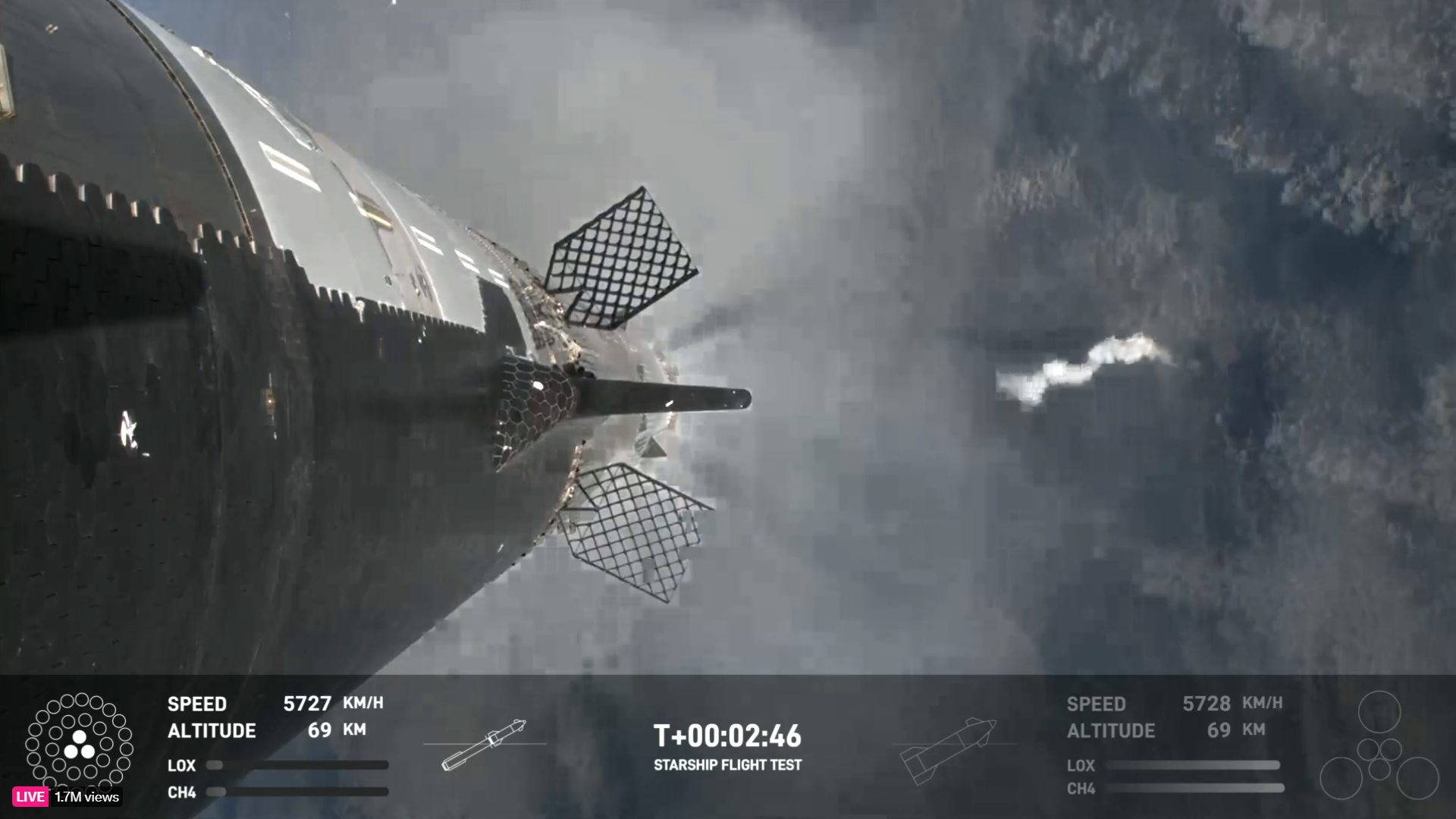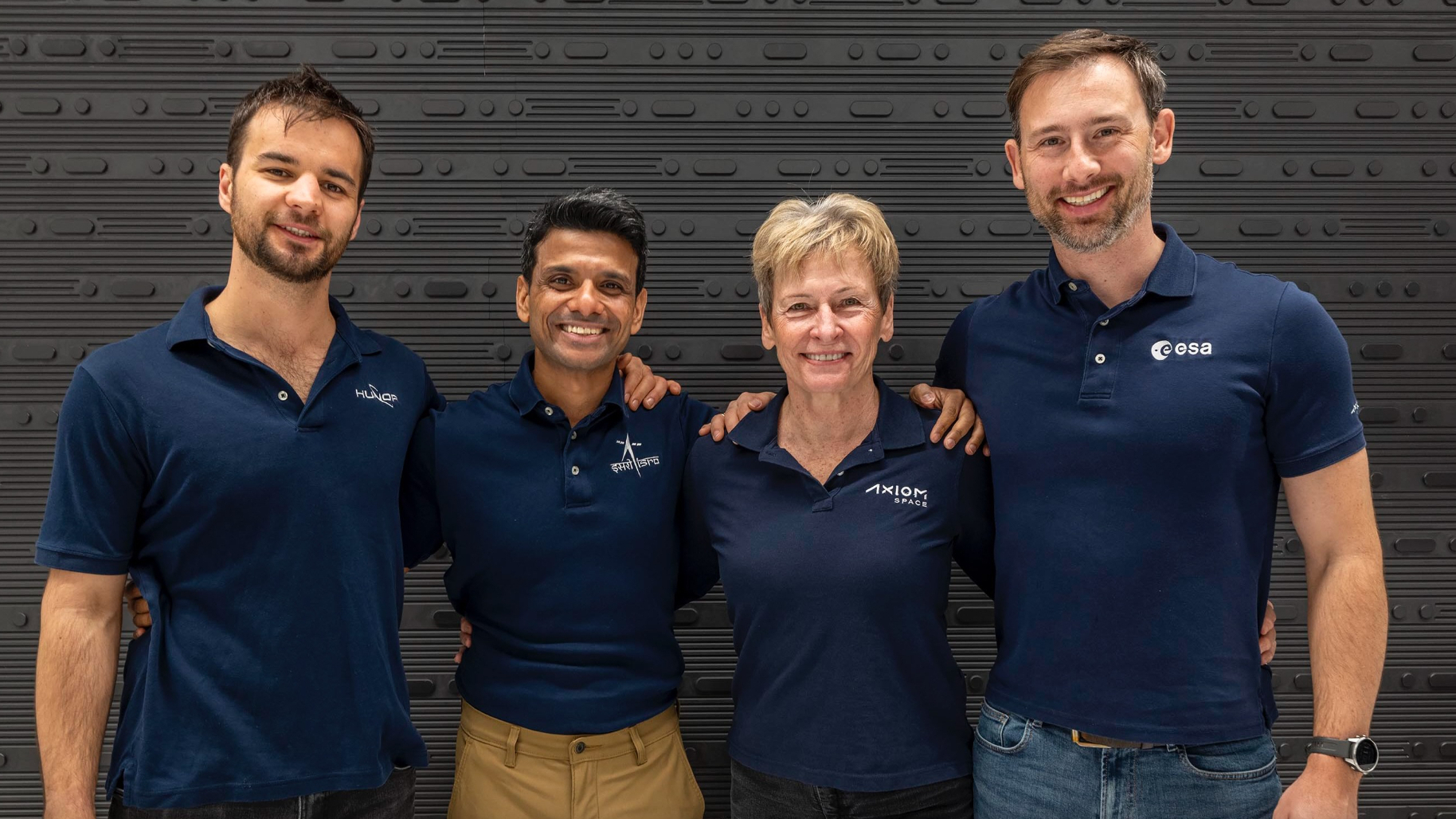SpaceX's giant Starship will be 500 feet tall for Mars missions, Elon Musk says (video)
Starship reached orbital speed during its 3rd launch in March.
SpaceX's Starship, the largest rocket in the world, will get even bigger as the company continues to target Mars missions in the future.
Elon Musk, the billionaire founder of SpaceX, told employees on April 4 that Starship will eventually be as tall as 500 feet (150 meters), roughly 20% higher than the massive system aboard the Super Heavy rocket right now.
What's more, advances in reusability will have each launch cost roughly $3 million each, Musk predicted; that's less than a third of what a (much smaller) Falcon 1 rocket launch cost in 2004 when inflation is taken into account. (The figure two decades ago was $5.9 million, according to NBC, which is roughly $9.5 million in 2024 dollars.)
"These are sort of unthinkable numbers," Musk said in the Starship update, released publicly April 6, roughly one month after the third and last test flight to date. "Nobody ever thought that this was possible, but we're not breaking any physics to achieve this. So this is within the bounds, without breaking physics. We can do this."
Related: SpaceX fires up huge Super Heavy booster ahead of 4th Starship test flight (photos, video)

Musk tends to deliver Starship updates at least once a year to highlight progress the company is making toward its long-term plans of settling Mars. Indeed, the last year has seen three Starship launches, so there has been progress made recently. Musk didn't, however, address delays in launching Starship that have contributed to pushing back the launch date for the first moon landing under the NASA-led Artemis program.
SpaceX was named the vendor for the Artemis 3 landing mission that, until recently, was set for 2025. In January, NASA elected to hold the launch date another year, to 2026, due to a range of technical issues. Aside from Starship not being ready — the agency wants many successful launches before approving it for astronaut flights — Artemis 3 was also delayed due to slow progress on spacesuits and problems with the mission's Orion spacecraft, among other factors.
Breaking space news, the latest updates on rocket launches, skywatching events and more!
However, Musk's words about Artemis, to employees, focused on Starship's future capabilities: orbiting the Earth and refilling its tanks, both of which have yet to be proven on its three test flights.
"This will ... be very important for the Artemis program for the NASA to get back to the moon," Musk said of those capabilities. He also envisions a "Moon Base Alpha" that would include ships "specialized for going to and from the moon", meaning there would be no heat shield or flaps due to the lack of atmosphere.

Musk's 45-minute speech touched on the usual themes for his Red Planet updates, focusing on how to send a lot of cargo out there for eventual settlers. He noted that would take thousands of launches to do; for perspective, Musk said the company has completed 327 successful Falcon series launches and about 80 percent of those had reused boosters (a key factor in reducing cost.)
SpaceX is by far the most active launching entity on Earth, and Musk forecasts the company will send roughly 90 percent of orbital mass aloft this year compared to China's 6 percent (the second-largest entity.)
Starship's next and fourth spaceflight attempt, expected to take place in May, aims to have the first stage of Super Heavy land "on essentially a virtual tower" in the Gulf of Mexico, Musk said. Once the company safely gets that done, they will consider using the launching area at Starbase, in south Texas, for future landings as soon as Flight 5. (Musk pegged the chances of success on Flight 4 at 80% or 90%.)
Musk also wants to perform two splashdowns of the upper stage of Starship in a row, in a controlled fashion, before sending it to Starbase on a future flight. "We do not want to rain debris over Mexico or the U.S.," he said. "My guess is probably next year when we will be able to reuse Starship."
Overall, Musk plans for multiple Starship launches to take place this year, and suggests SpaceX will build an additional six spacecraft by the end of 2024. A new rocket factory for the company should be available in 2025, which would make production even faster.
Future versions of Starship will include a "Starship 2" to send 100 tons of payload to low-Earth orbit and the 500-foot "Starship 3" for 200 or more tons. Bigger vehicles, Musk stressed, will mean fewer (four or five) refueling missions in low Earth orbit to get a Starship ready for the journey to Mars someday.
Of these milestones, Musk said it would be "very much a success-oriented schedule." His speech did not mention the Federal Aviation Administration, which must approve each one of the launches, nor ongoing criticism of the environmental impact of Starship on the ecologically sensitive area near Starbase.
That impact may continue to grow, as Musk said it would take roughly 10 launches a day to send hundreds of vehicles to Mars every two years (when the planet is closest) to make a long-term settlement feasible. As for the number of Mars-bound people, that would be roughly a million folks, he said — that matches predictions he made at least as far back as 2017. Musk also says he wants to get the settlement going "in 20 years." He said the same thing in 2011.
Join our Space Forums to keep talking space on the latest missions, night sky and more! And if you have a news tip, correction or comment, let us know at: community@space.com.

Elizabeth Howell (she/her), Ph.D., was a staff writer in the spaceflight channel between 2022 and 2024 specializing in Canadian space news. She was contributing writer for Space.com for 10 years from 2012 to 2024. Elizabeth's reporting includes multiple exclusives with the White House, leading world coverage about a lost-and-found space tomato on the International Space Station, witnessing five human spaceflight launches on two continents, flying parabolic, working inside a spacesuit, and participating in a simulated Mars mission. Her latest book, "Why Am I Taller?" (ECW Press, 2022) is co-written with astronaut Dave Williams.
-
Laz excessive superlatives; starship as it stands is problematic with the physical forces during launch,: it destroys it's own launch pad, scattering debris far and wide, the noise is harmful and damaging, and what about the carbon emissions ? a few test launches (failures) to develop the program....at what cost ? Do we need this ? What do we need to go to Mars for ? colonization ? go colonize Antarctica instead- it's far closer and far more habitable in comparison.Reply -
billslugg What you need to do is to become a "credentialed investor", go over the counter and buy some SpaceX stock, then float a stockholder proposal at the next annual meeting. Keep us appraised.Reply -
orsobubu The goal of 2026 for the year of the return (or, according to some, the conquest) of the moon, already postponed many times, seems unrealistic to me; still having to demonstrate the permanence in orbit, the refilling, the recovery of the first stage, the functionality of the starship capture mechanism upon re-entry, plus countless other critical issues... while 2025 is indicated as the year in which a few solutions will be carried out for the first time. Nasa also declares that it intends to see many missions completed successfully before starting artemis 3 (which is still a bit strange, given the vaunted success of the first attempts of many key apollo technologies on the moon, moreover 55 years ago), and this adds a whole series of problems of validating mind-boggling new systems in such a hostile environment. Nasa itself has postponed its objectives countless times - albeit much more limited - in view of artemis 3, such as the suits, the insertion of orion and starliner into orbit, etc.Reply -
orsobubu Reply
This martian base project is truly absurd, i believe it is technically and economically impossible, extremely dangerous and cause of enormous waste of resources; the basic philosophical and political economy idea is correct, in the sense that to prevent the collapse of the capitalist production system and the advent of social revolutions, a method to indefinitely increase the production of surplus value is absolutely necessary, given the limitation of terrestrial resources and markets, and this is why musk insists on the millions of workers on mars, the brain implants to make man competitive with machines, the robots equipped with artificial intelligence. But even if we want to accept this metaphysics of the end of history and therefore deny the social progress of the human species and its production system (which i absolutely do not accept), these methods seem completely utopian and indeed dystopian to me. There would be much more feasible alternative solutions such as the construction of moon or orbiting space bases or in any case close to the earth-moon system, using self-replicating nano-machines etc, or the attribution of full civil and property rights to humanoid automatons if they are to be used as a reservoir of capitalist surplus value. O'Neill's famous book is enlightening in this regard, and postpones the possibility of further interplanetary expansions of the human species until a community of space inhabitants has been well developed and will consider it within their physical and psychological reach. About antarctica, there is really something strange about the bans instituted for common people regarding the free exploration of those lands; much more critical and at risk ecosystems, such as rainforests, do not benefit from this treatment at all, and are actually destroyed forever at crazy rates. However, the flat earth conspiracists (a theory that i do not support in the slightest) have interesting theories in this regard, and in any case i don't think that a free market exploitation of the antarctic will ever be allowed, perhaps for reasons that cannot be revealed.Laz said:excessive superlatives; starship as it stands is problematic with the physical forces during launch,: it destroys it's own launch pad, scattering debris far and wide, the noise is harmful and damaging, and what about the carbon emissions ? a few test launches (failures) to develop the program....at what cost ? Do we need this ? What do we need to go to Mars for ? colonization ? go colonize Antarctica instead- it's far closer and far more habitable in comparison. -
Unclear Engineer If humans don't manage to kill ourselves off by the time Antarctica has melted enough to be colonized, I am sure it will happen. Greenland much sooner.Reply -
HobartStinsonian There are huge problems to overcome before landing any long-term presence on Mars, or on the moon. Basic engineering: how much weight can the soil support? No idea? You can’t rely on any ship remaining level, not sinking down, until you get this figured out to high reliability. Second issue, what will the effect be of spilling fluids onto the soil to its compressive strength? Consider the soils have been dessicated for billions of years. Then a small spill of water or oil soaks in next to a structural support that sits on that soil. No idea? I bet the impact will be huge and devestating. Will Elon experiment with soils before they land a 500-ft Starship on that soil? The first equipment on moon & Mars needs to be heavy soil-excavating, and heavy mobile cranes. We’ll need to know how to make concrete-like foundations. And how deep do they need to be.Reply -
Rob77 Reply
While I agree with all the problems you have mentioned I firmly believe we still need to advance beyond our own planet. Obviously wont happen in our life time but we have a naturally driven curiosity - I'm constantly reminded about JFK speech - why go to the moon?Laz said:excessive superlatives; starship as it stands is problematic with the physical forces during launch,: it destroys it's own launch pad, scattering debris far and wide, the noise is harmful and damaging, and what about the carbon emissions ? a few test launches (failures) to develop the program....at what cost ? Do we need this ? What do we need to go to Mars for ? colonization ? go colonize Antarctica instead- it's far closer and far more habitable in comparison.
Saying that, there's another drive too, part of our human nature - a big ego to be the "first". I believe Elon or at least SpaceX wants to be the first to Mars.
